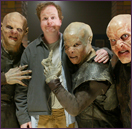
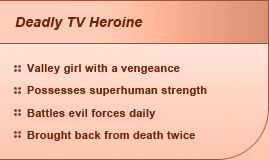
I just wanna have a life, I wanna do something normal. Something safe.
—Buffy Summers
It’s a quiet evening in a small town, somewhere in California. A teenager sets out, dressed-up for a night with her friends. As she walks alone down a dark, empty street, she hears footsteps behind her. She pauses. Creepily, the footsteps come to a stop. Spooked, she picks up her pace, but a shadow follows close behind. She turns a corner quickly … but it’s a dead end! Trapped, she panics …
A tall, brooding man dressed in black emerges calmly from the dark—the girl is nowhere to be found. Silently planted into a perfect handstand on a pipe high above him, she swoops downward, knocking him to the ground with ease.
“Why are you following me?” she asks, planting a foot on the stalker’s chest.
“I know what you’re thinking,” he responds, grinning, “but don’t worry, I don’t bite. The truth is, I thought you’d be taller, or bigger muscles and all that.”
Killer Character
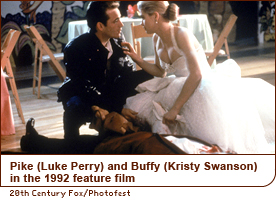 After decades of watching pretty-girl victims easily slayed by any story line’s villain, audiences were introduced to a new kind of heroine in the 1990s. Her name was Buffy Summers—a teenage delinquent who was cute, witty, short and capable of kicking evil’s butt in any form. Buffy and her friends averted the apocalypse first in a feature film and then for seven seasons on TV, preventing world domination by a seemingly endless supply of underworld characters: demons, shape-shifters, ghosts, gods, trolls, zombies and, of course, vampires.
After decades of watching pretty-girl victims easily slayed by any story line’s villain, audiences were introduced to a new kind of heroine in the 1990s. Her name was Buffy Summers—a teenage delinquent who was cute, witty, short and capable of kicking evil’s butt in any form. Buffy and her friends averted the apocalypse first in a feature film and then for seven seasons on TV, preventing world domination by a seemingly endless supply of underworld characters: demons, shape-shifters, ghosts, gods, trolls, zombies and, of course, vampires.
Buffy first came into existence in 1992 as the brainchild of screenwriter Joss Whedon. A horror-movie junkie and self-admitted feminist, Whedon sought to challenge the stereotype of the weak and defenseless young woman who was always the first to die in the countless films of the genre. He created the ultimate antithesis in Buffy the Vampire Slayer, a movie that starred Kristy Swanson as Buffy Summers, a ditsy cheerleader who discovers that she has been chosen by higher powers to protect the world from vampires. She and her sidekick/love interest Pike, played by Luke Perry (Beverly Hills, 90210), save their high-school class from perishing at the hands of vicious vampires who crash their prom. The film was a box-office flop, although it resonated with some teen audiences.
When Buffy reemerged as a TV series in March 1997, the vampire-fighter legend was born through Sarah Michelle Gellar, a spunky soap actress who had previously starred for two seasons on All My Children.
Blood-Sucking Good
Picking up where the movie left off, the TV show opens with Buffy and her recently divorced mom moving from Los Angeles to the fictional California suburb of Sunnydale—“a one-Starbucks town” according to resident snob Cordelia Chase (Charisma Carpenter), or, in Buffy’s words, “two hours on the freeway from Neiman Marcus”—to start a new life. Buffy thinks she has escaped her past life as a Slayer, but the sophomore transfer student soon finds out that her fighting days have just begun: Sunnydale High School is built over the “Hellmouth,” an epicenter of demonic energy.
Under the tutelage of Watcher (a Slayer mentor) and school librarian Rupert Giles (Anthony Stewart Head), Buffy and her crew battle their enemies using extensive knowledge of ancient and mystical texts, various forms of magic and intense physical combat that often results in high body counts.
Buffy quips to Giles in “Welcome to the Hellmouth,” the show’s first episode, “It’s my first day [at this school]. I thought I was going to be behind in all my classes, that I wouldn’t make any friends, that I would have last month’s hair. I didn’t think there would be vampires on campus.”
This is the beginning of an ongoing struggle: living up to her Slayer responsibilities—basically, battling the undead—while trying to deal with the everyday problems of a teenage girl. And what better setting to explore this unique conflict than high school?
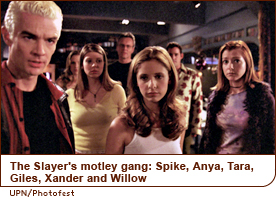 For Buffy creator Whedon, “high school was one long horror story.” His teenage traumas provided him with plenty of material for tackling teenage life in the series, but Whedon turned up the drama a notch. While attending Sunnydale High School, Buffy experiences forbidden love, falling for Angel (David Boreanaz), a vampire with a soul, and canoodling much later in the series with soulless-vampire-with-nonviolent-microchip-in-the-head Spike (James Marsters). Buffy’s sidekicks also have their share of love woes: Witch-in-training Willow (Alyson Hannigan) discovers that her boyfriend, Oz (Seth Green), is a werewolf; lovable geek Xander (Nicholas Brendon) dates 1,100-year-old former vengeance demon Anya (Emma Caulfield), who has a phobia of bunnies. In addition to matters of the heart, episodes explored other teen issues such as the harshness of social cliques, premarital sex, depression and peer pressure.
For Buffy creator Whedon, “high school was one long horror story.” His teenage traumas provided him with plenty of material for tackling teenage life in the series, but Whedon turned up the drama a notch. While attending Sunnydale High School, Buffy experiences forbidden love, falling for Angel (David Boreanaz), a vampire with a soul, and canoodling much later in the series with soulless-vampire-with-nonviolent-microchip-in-the-head Spike (James Marsters). Buffy’s sidekicks also have their share of love woes: Witch-in-training Willow (Alyson Hannigan) discovers that her boyfriend, Oz (Seth Green), is a werewolf; lovable geek Xander (Nicholas Brendon) dates 1,100-year-old former vengeance demon Anya (Emma Caulfield), who has a phobia of bunnies. In addition to matters of the heart, episodes explored other teen issues such as the harshness of social cliques, premarital sex, depression and peer pressure.
As Buffy and her friends barely survive their high-school years and enter college, they continue to battle internal and external demons while facing even more drama. Plots centered on living with roommates from hell (literally), battling scantily dressed but deadly gods, losing parents and mentors unexpectedly, exploring their sexuality, overcoming addiction, accepting new allies (often past enemies) and saying good-bye to old friends.
A Cult Heroine Is Born
Before Buffy, the only women who kicked ass on television did so metaphorically, in the courtrooms or in the ER.
—Slate
Buffy the Vampire Slayer was anything but orthodox. The show was an amalgam of many genres—sci-fi, drama, romance, comedy, horror and martial arts—with an adorable but fierce heroine, an attractive cast of superfriends and witty banter that captured the fears and anxieties of young adulthood. Unlike the movie, the series became a critical and cult hit, receiving Emmy Award nominations and inspiring worldwide Buffy clubs.
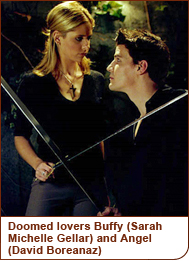 Part of Buffy’s appeal had to do with her eternally doomed romance with Angel (Angelus, when he’s evil), the dark, tall and handsome vampire-with-a-conscience who aids Buffy in her battles. While viewers swooned during Buffy’s love encounters, female viewers could also feel empowered by her displays of strength, courage and leadership. Unaided, Buffy could kill several demons within minutes. She never cowered in fear or waited helplessly to be rescued by a stronger male hero. And she was a teenage girl entrusted to protect the world from evil.
Part of Buffy’s appeal had to do with her eternally doomed romance with Angel (Angelus, when he’s evil), the dark, tall and handsome vampire-with-a-conscience who aids Buffy in her battles. While viewers swooned during Buffy’s love encounters, female viewers could also feel empowered by her displays of strength, courage and leadership. Unaided, Buffy could kill several demons within minutes. She never cowered in fear or waited helplessly to be rescued by a stronger male hero. And she was a teenage girl entrusted to protect the world from evil.
Buffy inspired several comic books, magazines, companion books, novelizations, video games, websites, online discussion forums, works of fan fiction and even soundtrack albums. The show’s cultural influence was so undeniable that even academics took notice. Buffy is the subject of several published essays, academic journals and college courses. In May 2004, 390 “Buffyologists” from 39 U.S. states and seven countries gathered in Nashville to listen to more than 190 papers on Buffy topics such as “Slayer slang,” “postmodern reflections on the culture of consumption” and “Buffy and the new American Buddhism.” The conference was coordinated by Slayage, an online academic journal dedicated to the study of Buffy the Vampire Slayer.
Although the series ended in 2003, creator Whedon has announced his plans to reveal where Buffy goes after leaving Sunnydale in a comic-book series for Dark Horse Comics. In a December 23, 2005, interview with USA Today, Whedon said that he’ll actually write the first four comics himself and that readers should view the comics as a sequel to the previous seasons.
Kick-Ass Role Model
Buffy is an ongoing lesson in this sisters-doing-it-for-themselves ideology: She never claims to be “just a girl.” She never denigrates herself, nor is her girlhood ever depicted as a detraction. By contrast, it’s the very source of her strength.
—Bitch magazine
Before Buffy, the only TV action heroines who’d garnered widespread popularity were 1970s-era Wonder Woman and the Bionic Woman. Although Buffy did possess supernatural powers, they were enhancements of her natural abilities, which provided a more empowering message to girl viewers than the suggestion that only those with fantastical superpowers can be heroines.
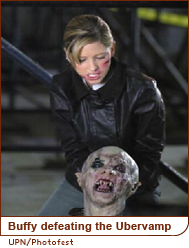 The series was careful to regularly include scenes of Buffy’s martial-arts training to show viewers that they too could train to fight like Buffy. By the end of the series, Buffy and her friends were running a school for potential Slayers. In its final episode, girls around the world were instantly endowed with Slayer powers.
The series was careful to regularly include scenes of Buffy’s martial-arts training to show viewers that they too could train to fight like Buffy. By the end of the series, Buffy and her friends were running a school for potential Slayers. In its final episode, girls around the world were instantly endowed with Slayer powers.
It’s no accident that Buffy was introduced to audiences in the 1990s, when antirape movements and self-defense classes for women were on the rise. But Buffy took things a step further—she taught girls and women that they could not only defend themselves, but that they were strong and capable enough to protect others.
:: Linda Apeles
Read More About Buffy the Vampire Slayer






